Phosphorous acid,tris(4-methylphenyl) ester
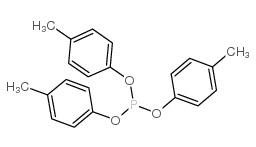
Phosphorous acid,tris(4-methylphenyl) ester structure
|
Common Name | Phosphorous acid,tris(4-methylphenyl) ester | ||
|---|---|---|---|---|
| CAS Number | 620-42-8 | Molecular Weight | 352.36300 | |
| Density | 1.11 | Boiling Point | 238ºC (7 mmHg) | |
| Molecular Formula | C21H21O3P | Melting Point | 52°C | |
| MSDS | N/A | Flash Point | 93ºC | |
| Name | phosphorous acid tris(4-methylphenyl) ester |
|---|---|
| Synonym | More Synonyms |
| Density | 1.11 |
|---|---|
| Boiling Point | 238ºC (7 mmHg) |
| Melting Point | 52°C |
| Molecular Formula | C21H21O3P |
| Molecular Weight | 352.36300 |
| Flash Point | 93ºC |
| Exact Mass | 352.12300 |
| PSA | 41.28000 |
| LogP | 6.37550 |
| Appearance of Characters | solid |
| Index of Refraction | 1.5724-1.5744 |
Synonym:Phosphorous Acid, Tris(4-Methylphenyl) Ester Section 2 - COMPOSITION, INFORMATION ON INGREDIENTS
Risk Phrases: 34 Section 3 - HAZARDS IDENTIFICATION EMERGENCY OVERVIEW
Causes burns.Corrosive. Potential Health Effects Eye: Causes eye burns. May cause chemical conjunctivitis and corneal damage. Skin: Causes skin burns. May cause cyanosis of the extremities. May cause skin rash (in milder cases), and cold and clammy skin with cyanosis or pale color. Ingestion: Causes gastrointestinal tract burns. May cause perforation of the digestive tract. May cause cardiac disturbances. May cause corrosion and permanent tissue destruction of the esophagus and digestive tract. May cause central nervous system effects. May cause systemic effects. Inhalation: Causes chemical burns to the respiratory tract. May cause abdominal pain, nausea, vomiting, and inflammation of the gums and mouth. Aspiration may lead to pulmonary edema. May cause cardiac abnormalities. May cause systemic effects. Inhalation at high concentrations may cause CNS depression and asphixiation. Chronic: Effects may be delayed. Section 4 - FIRST AID MEASURES Eyes: Get medical aid immediately. Do NOT allow victim to rub eyes or keep eyes closed. Extensive irrigation with water is required (at least 30 minutes). Skin: Get medical aid immediately. Immediately flush skin with plenty of water for at least 15 minutes while removing contaminated clothing and shoes. Wash clothing before reuse. Destroy contaminated shoes. Ingestion: Do not induce vomiting. If victim is conscious and alert, give 2-4 cupfuls of milk or water. Never give anything by mouth to an unconscious person. Get medical aid immediately. Wash mouth out with water. Inhalation: Get medical aid immediately. Remove from exposure and move to fresh air immediately. If breathing is difficult, give oxygen. Do NOT use mouth-to-mouth resuscitation. If breathing has ceased apply artificial respiration using oxygen and a suitable mechanical device such as a bag and a mask. Notes to Physician: Section 5 - FIRE FIGHTING MEASURES General Information: As in any fire, wear a self-contained breathing apparatus in pressure-demand, MSHA/NIOSH (approved or equivalent), and full protective gear. During a fire, irritating and highly toxic gases may be generated by thermal decomposition or combustion. Will burn if involved in a fire. Combustible liquid. Can form explosive mixtures at temperatures above the flashpoint. Use water spray to keep fire-exposed containers cool. Combustible liquid. Vapors may be heavier than air. They can spread along the ground and collect in low or confined areas. Containers may explode when heated. Runoff from fire control or dilution water may cause pollution. Extinguishing Media: Use water spray to cool fire-exposed containers. Use water spray, dry chemical, carbon dioxide, or chemical foam. Section 6 - ACCIDENTAL RELEASE MEASURES General Information: Use proper personal protective equipment as indicated in Section 8. Spills/Leaks: Absorb spill with inert material (e.g. vermiculite, sand or earth), then place in suitable container. Avoid runoff into storm sewers and ditches which lead to waterways. Clean up spills immediately, observing precautions in the Protective Equipment section. Remove all sources of ignition. Use a spark-proof tool. Provide ventilation. Section 7 - HANDLING and STORAGE Handling: Wash thoroughly after handling. Use only in a well-ventilated area. Do not breathe dust, vapor, mist, or gas. Do not get in eyes, on skin, or on clothing. Empty containers retain product residue, (liquid and/or vapor), and can be dangerous. Keep container tightly closed. Keep away from heat, sparks and flame. Do not ingest or inhale. Discard contaminated shoes. Do not pressurize, cut, weld, braze, solder, drill, grind, or expose empty containers to heat, sparks or open flames. Storage: Keep away from sources of ignition. Store in a tightly closed container. Store in a cool, dry, well-ventilated area away from incompatible substances. Corrosives area. Section 8 - EXPOSURE CONTROLS, PERSONAL PROTECTION Engineering Controls: Facilities storing or utilizing this material should be equipped with an eyewash facility and a safety shower. Use adequate ventilation to keep airborne concentrations low. Exposure Limits CAS# 620-42-8: Personal Protective Equipment Eyes: Wear appropriate protective eyeglasses or chemical safety goggles as described by OSHA's eye and face protection regulations in 29 CFR 1910.133 or European Standard EN166. Skin: Wear appropriate protective gloves to prevent skin exposure. Clothing: Wear appropriate protective clothing to prevent skin exposure. Respirators: Follow the OSHA respirator regulations found in 29 CFR 1910.134 or European Standard EN 149. Use a NIOSH/MSHA or European Standard EN 149 approved respirator if exposure limits are exceeded or if irritation or other symptoms are experienced. Section 9 - PHYSICAL AND CHEMICAL PROPERTIES Physical State: Clear liquid Color: slightly yellow Odor: Not available. pH: Not available. Vapor Pressure: Not available. Viscosity: Not available. Boiling Point: 238 deg C @ 7.00mmHg Freezing/Melting Point: Not available. Autoignition Temperature: Not available. Flash Point: 93 deg C ( 199.40 deg F) Explosion Limits, lower: Not available. Explosion Limits, upper: Not available. Decomposition Temperature: Solubility in water: miscible with acetone, alcohol, benzene, Specific Gravity/Density: 1.1150g/cm3 Molecular Formula: Molecular Weight: 352.36 Section 10 - STABILITY AND REACTIVITY Chemical Stability: Stable under normal temperatures and pressures. Conditions to Avoid: Incompatible materials, ignition sources, excess heat. Incompatibilities with Other Materials: Oxidizing agents Hazardous Decomposition Products: Carbon monoxide, oxides of phosphorus, irritating and toxic fumes and gases, carbon dioxide. Hazardous Polymerization: Will not occur. Section 11 - TOXICOLOGICAL INFORMATION RTECS#: CAS# 620-42-8: TH1100000 LD50/LC50: Not available. Carcinogenicity: Tri-P-Tolyl Phosphite - Not listed by ACGIH, IARC, or NTP. Other: See actual entry in RTECS for complete information. Section 12 - ECOLOGICAL INFORMATION Ecotoxicity: Fish: Pseudomonas putida: Section 13 - DISPOSAL CONSIDERATIONS Dispose of in a manner consistent with federal, state, and local regulations. Section 14 - TRANSPORT INFORMATION IATA Shipping Name: CORROSIVE LIQUID, N.O.S.* Hazard Class: 8 UN Number: 1760 Packing Group: III IMO Shipping Name: CORROSIVE LIQUID, N.O.S. Hazard Class: 8 UN Number: 1760 Packing Group: III RID/ADR Shipping Name: CORROSIVE LIQUID, N.O.S. Hazard Class: 8 UN Number: 1760 Packing group: III Section 15 - REGULATORY INFORMATION European/International Regulations European Labeling in Accordance with EC Directives Hazard Symbols: C Risk Phrases: R 34 Causes burns. Safety Phrases: S 25 Avoid contact with eyes. S 36/37/39 Wear suitable protective clothing, gloves and eye/face protection. S 45 In case of accident or if you feel unwell, seek medical advice immediately (show the label where possible). WGK (Water Danger/Protection) CAS# 620-42-8: No information available. Canada CAS# 620-42-8 is listed on Canada's NDSL List. CAS# 620-42-8 is not listed on Canada's Ingredient Disclosure List. US FEDERAL TSCA CAS# 620-42-8 is listed on the TSCA inventory. SECTION 16 - ADDITIONAL INFORMATION N/A |
CHEMICAL IDENTIFICATION
HEALTH HAZARD DATAACUTE TOXICITY DATA
|
| Hazard Codes | C |
|---|---|
| Risk Phrases | 34 |
| Safety Phrases | S25;S45;S36/S37/S39 |
| RTECS | TH1100000 |
| HS Code | 2920901900 |
|
~90% 
Phosphorous aci... CAS#:620-42-8 |
| Literature: Ho, Chun-Yu; Chan, Chun-Wa; Wo, Siu-Kwan; Zuo, Zhong; Chan, Lai-Ying Organic and Biomolecular Chemistry, 2010 , vol. 8, # 15 p. 3480 - 3487 |
|
~57% 
Phosphorous aci... CAS#:620-42-8 |
| Literature: Ivanov, B. E.; Badeeva, E. K.; Krokhina, S. S. Bulletin of the Academy of Sciences of the USSR, Division of Chemical Science (English Translation), 1988 , vol. 37, # 11 p. 2371 - 2373 Izvestiya Akademii Nauk SSSR, Seriya Khimicheskaya, 1988 , # 11 p. 2632 - 2634 |
|
~% 
Phosphorous aci... CAS#:620-42-8 |
| Literature: Chemische Berichte, , vol. 31, p. 1051 |
| Precursor 3 | |
|---|---|
| DownStream 7 | |
| HS Code | 2920901900 |
|---|---|
| Summary | 2920901900 VAT:17.0% Tax rebate rate:9.0% Supervision conditions:none MFN tariff:6.5% General tariff:30.0% |
| EINECS 210-639-9 |
| MFCD00041909 |
| Tri-p-tolyl phosphite,tech. |
| tri-p-tolyl phosphite |
| PHOSPHOROUS ACID TRI-P-TOLYL ESTER |
| TRI-P-CRESYL PHOSPHITE |


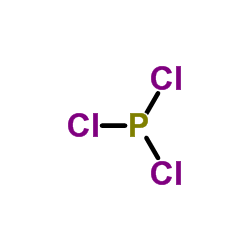
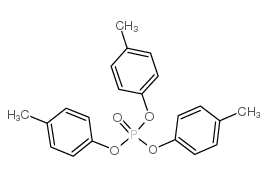 CAS#:78-32-0
CAS#:78-32-0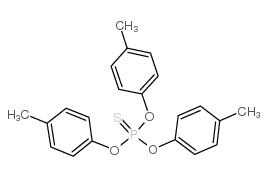 CAS#:597-84-2
CAS#:597-84-2 CAS#:3553-61-5
CAS#:3553-61-5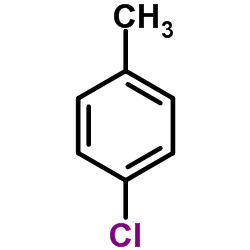 CAS#:106-43-4
CAS#:106-43-4 CAS#:13869-19-7
CAS#:13869-19-7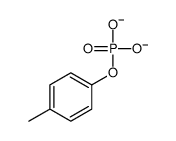 CAS#:6729-45-9
CAS#:6729-45-9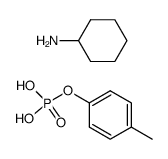 CAS#:79227-86-4
CAS#:79227-86-4